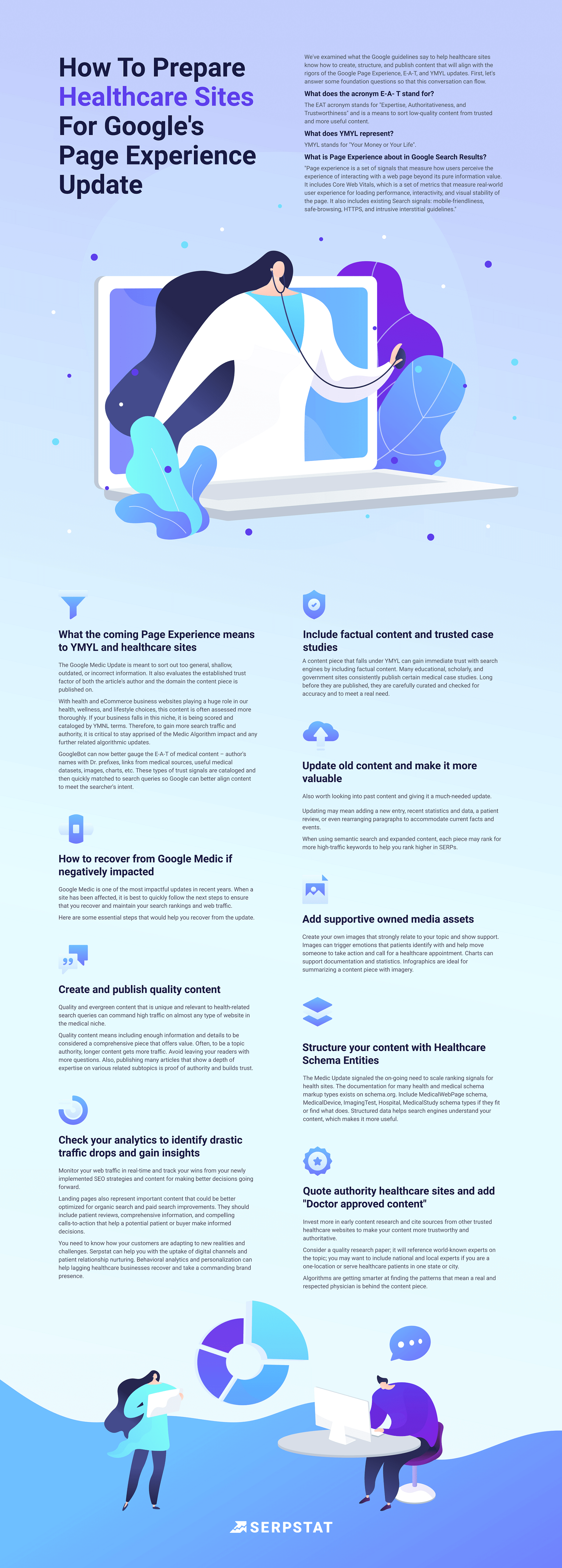Start Exploring Keyword Ideas
Use Serpstat to find the best keywords for your website
How To Prepare Healthcare Sites For Google's Page Experience Update [Infographic]

We've examined what the Google guidelines say to help healthcare sites know how to create, structure, and publish content that will align with the rigors of the Google Page Experience, E-A-T, and YMYL updates. First, let's answer some foundation questions so that this conversation can flow.
The EAT acronym stands for "Expertise, Authoritativeness, and Trustworthiness" and is a means to sort low-quality content from trusted and more useful content.
YMYL stands for "Your Money or Your Life".
"Page experience is a set of signals that measure how users perceive the experience of interacting with a web page beyond its pure information value. It includes Core Web Vitals, which is a set of metrics that measure real-world user experience for loading performance, interactivity, and visual stability of the page. It also includes existing Search signals: mobile-friendliness, safe-browsing, HTTPS, and intrusive interstitial guidelines."
2. How to recover from Google Medic if negatively impacted
2.1 Create and publish quality content
2.2 Quote authority healthcare sites and add "Doctor Approved Content"
2.3 Include factual content and trusted case studies
2.4 Update old content and make it more valuable
2.5 Add supportive owned media assets
2.6 Structure your content with Healthcare Schema Entities
Identifying and cataloging exceptional and trusted E-A-T content is of top importance. Every search engine wants to ensure that people will be led to reliable, accurate, relevant content that offers an excellent page experience. Our current pandemic underscores this need like little else that most of us have experienced in our lifetimes. Patients need the right answers, and often, they need them fast.
With health and eCommerce business websites playing a huge role in our health, wellness, and lifestyle choices, this content is often assessed more thoroughly. If your business falls in this niche, it is being scored and cataloged by YMNL terms. Therefore, to gain more search traffic and authority, it is critical to stay apprised of the Medic Algorithm impact and any further related algorithmic updates.
There is a huge effort underfoot to promote patient safety and protect people from misinformation.
GoogleBot can now better gauge the E-A-T of medical content – author's names with Dr. prefixes, links from medical sources, useful medical datasets, images, charts, etc. These types of trust signals are cataloged and then quickly matched to search queries so Google can better align content to meet the searcher's intent.
Quality content means including enough information and details to be considered a comprehensive piece that offers value. Often, to be a topic authority, longer content gets more traffic. Avoid leaving your readers with more questions and needing to go somewhere else to find those related answers. Also, publishing many articles that show a depth of expertise on various related subtopics is proof of authority and builds trust.
Algorithms are getting smarter at finding the patterns that mean a real and respected physician is behind the content piece. This may also be a business identified in the health sector (by showing ties with national healthcare systems, authoritative accrediting bodies such as The Food and Drug Law Institute, HIPAA, the CDC, the AACD fellowship, and so on.
Even someone within a medical practice who is writing can seek a doctor to read, edit, and approve any content pieces before publishing. This will show that the author has an attentiveness for detail and intent to offer correct and verified content. Along with the author bio, add, "This article was edited and approved for accurateness by Dr. ____________."
FactCheck schema markup alerts search engines of factual and sourced content. You will need to provide the author's name/title/image, where the article was published, date of publication, article title, the publisher's logo, and other key details to validate your markup. The author should add their opinion and reason for referencing the fact so that the article flows for the reader.
This helps build entity relationships with influencers, professors, government agencies with regulatory or oversight, and well-established topic experts. Here is a helpful list of United States Federal Healthcare Agencies.
News articles are another matter and best left if unchanged to ensure journalistic professionalism. They reflect what happened at the time of publication.
How-to articles, FAQ pages, and topic expansions can use fresh information that coincides with healthcare's latest happenings, needs, and regulations. They can improve their potential reach to attract more readers. When using semantic search and expanded content, each piece may rank for more high-traffic keywords to help you rank higher in SERPs.
Create your own images that strongly relate to your topic and show support. Images can trigger emotions that patients identify with and help move someone to take action and call for a healthcare appointment. Charts can support documentation and statistics. Infographics are ideal for summarizing a content piece with imagery.
Landing pages also represent important content that could be better optimized for organic search and paid search improvements. AMP landing pages are fast and can offer all elements needed along each step in the buyer's journey.
Landing pages should include patient reviews, comprehensive information, and compelling calls-to-action that help a potential patient or buyer make informed decisions. Understand what is behind ranking ups and downs will lead to more conversions and polished communications.
AI tools and platforms like Serpstat are in place to help businesses grow. Search marketers rely on data reports that inform SEO's of rankings changes and the strengths of clients' competitors and weaknesses that provide exciting opportunities.
You need to know how your customers are adapting to new realities and challenges. Serpstat can help you with the uptake of digital channels and patient relationship nurturing. Behavioral analytics and personalization can help lagging healthcare businesses recover and take a commanding brand presence.

To keep track of all the news from the Serpstat blog, subscribe to our newsletter. And also join our group on Facebook and follow our Twitter.
Speed up your search marketing growth with Serpstat!
Keyword and backlink opportunities, competitors' online strategy, daily rankings and SEO-related issues.
A pack of tools for reducing your time on SEO tasks.
Discover More SEO Tools
Backlink Cheсker
Backlinks checking for any site. Increase the power of your backlink profile
API for SEO
Search big data and get results using SEO API
Competitor Website Analytics
Complete analysis of competitors' websites for SEO and PPC
Keyword Rank Checker
Google Keyword Rankings Checker - gain valuable insights into your website's search engine rankings
Recommended posts
Cases, life hacks, researches, and useful articles
Don’t you have time to follow the news? No worries! Our editor will choose articles that will definitely help you with your work. Join our cozy community :)
By clicking the button, you agree to our privacy policy.

